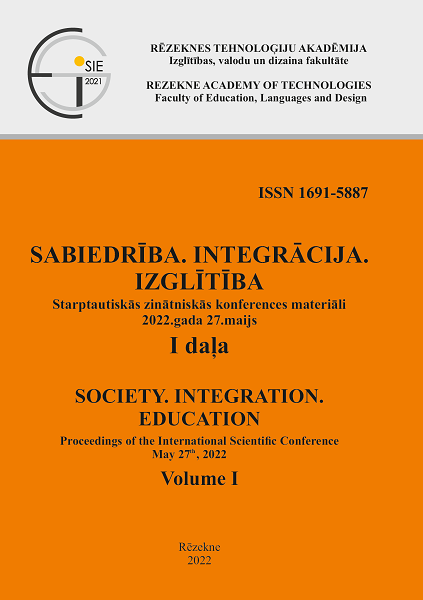OPPORTUNITIES OF THE IMPLEMENTATION OF BLENDED LEARNING
DOI:
https://doi.org/10.17770/sie2022vol1.6877Keywords:
asynchronous and synchronous remote learning, blended learning, online learningAbstract
So far one of the 21st century biggest global events that brought about unforeseen changes in education was the pandemic caused by the SARS-CoV-19 virus. Measures to reduce the spread of the virus have made it necessary to replace traditional face-to-face education with alternative options, such as distance learning or remote learning. Blended learning, which combines face-to-face and online learning and is seen as a solution for future education, has also become relevant during the pandemic, providing an opportunity to promote the integration of digital technologies into learning process and to support equal access to education for all.
The article deals with a case study to explore the principles of the implementation of blended learning and pilot them in a higher education institution. Based on the theory review, it has been concluded that blended learning is defined as a method and an approach, as well as a curriculum that combines face-to-face learning with online learning. The data have been collected by the content analysis of documents, questionnaires for students and lecturers and an interview with the director of a higher education institution. The obtained data allow to develop the recommendations for the management of higher education institution, lecturers and students for the implementation of blended learning in the study process.
References
Allen, I.E., & Seaman, J. (2008). Staying the Course: Online Education in the United States, 2008. Needham, Massachusetts: Sloan Consortium.
Anderson, T. (2011). Towards a Theory of Online Learning. In T. Anderson (Ed.), The Theory and Practice of Online Learning. 2nd Edition (pp. 45–74). Edmonton: Athabasca University Press.
B-Learning. (2017). The Blended Learning Toolkits. B-Learning. Retrieved from https://blearning-project.eu/index.php/toolkit
Bonk, C.J., & Graham, C.R. (2006). Blended Learning Systems. In C.R. Graham (Ed.) The Handbook of Blended Learning: Global Perspectives, Local Designs, (pp. 3-21). San Francisco: Pfeiffer.
Christensen, C.M., Horn, M.B., & Staker, H. (2013). Is K-12 Blended Learning Disruptive? An Introduction of the Theory of Hybrids. Christensen Institute. Retrieved from http://www.christenseninstitute.org/wp-content/uploads/2013/05/Is-K-12-Blended-Learning-Disruptive.pdf
Cronje, J. (2020). Towards a New Definition of Blended Learning. Electronic Journal of E-Learning, 18(2), 114-121. DOI: https://doi.org/10.34190/EJEL.20.18.2.001
Eiropas Komisija. (2021). Padomes ieteikums par kombinētu mācīšanos kvalitatīvai un iekļaujošai pamatizglītībai un vidējai izglītībai. Pieejams: https://eur-lex.europa.eu/legal-content/LV/TXT/PDF/?uri=COM:2021:455:FIN&from=EN
Garrison, D.R., & Vaughan, N.D. (2008). Blended Learning in Higher Education: Framework, Principles, and Guidelines. San Francisco: John Wiley & Sons.
Garrrison, D.R., & Kanuka, H. (2004). Blended Learning: Uncovering its Transformative Potential in Higher Education. The Internet and Higher Education, 7(2), 95-105.
Graham, C.R. (2009). Blended Learning Models. Encyclopedia of Information Science and Technology (2nd ed., pp. 375– 382). Hershey, PA: IGI Global. DOI: http://doi:10.4018/978-1-60566-026-4.ch063
Grosberga-Merca, S. (2021). Kombinēto mācību īstenošanas iespējas medicīnas koledžā. Rīga: Latvijas Universitāte.
Güzer, B., & Caner, H. (2014). The Past, Present and Future of Blended Learning: an in Depth Analysis of Literature. Procedia – Social and Behavioral Sciences, 116, 4596-4603. DOI: https://doi.org/10.1016/j.sbspro.2014.01.992
Shelton, K., & Saltsman, G. (2005). An Administrator's Guide to Online Education. Greenwich, Connecticut: IAP.
Staker, H., & Horn, M.B. (2012). Classifying K-12 Blended Learning. Innosight Institute.
The United Nations Educational, Scientific and Cultural Organization (UNESCO). (2020). Education: from Disruption to Recovery. UNESCO. Retrieved from https://en.unesco.org/covid19/educationresponse#schoolclosures
Valsts izglītības satura centrs. (2020). Vadlīnijas klātienes, kombinētu un attālinātu mācību īstenošanai. Metodiskie ieteikumi vispārējās un profesionālās izglītības iestādēm COVID-19 izplatības laikā. Izglītības un zinātnes ministrija. Pieejams: https://www.izm.gov.lv/lv/media/5053/download
Wiepcke, C. (2006). Computergestützte Lernkonzepte und deren Evaluation in der Weiterbildung. Blended Learning zur Förderung von Gender Mainstreaming. Hamburg: Kovac.
Young, A.E. and Duhaney, D.C. (2008). Hybrid Learning and the Principles of Good Practice in Undergraduate Education. International Journal of Instructional Technology and Distance Learning. Retrieved from http://www.itdl.org/Journal/Nov_08/article04.htm
Yu, Z. (2015). Blended Learning over Two Decades. International Journal of Information and Communication Technology Education. 11. 1-19. DOI: 10.4018/IJICTE.2015070101






